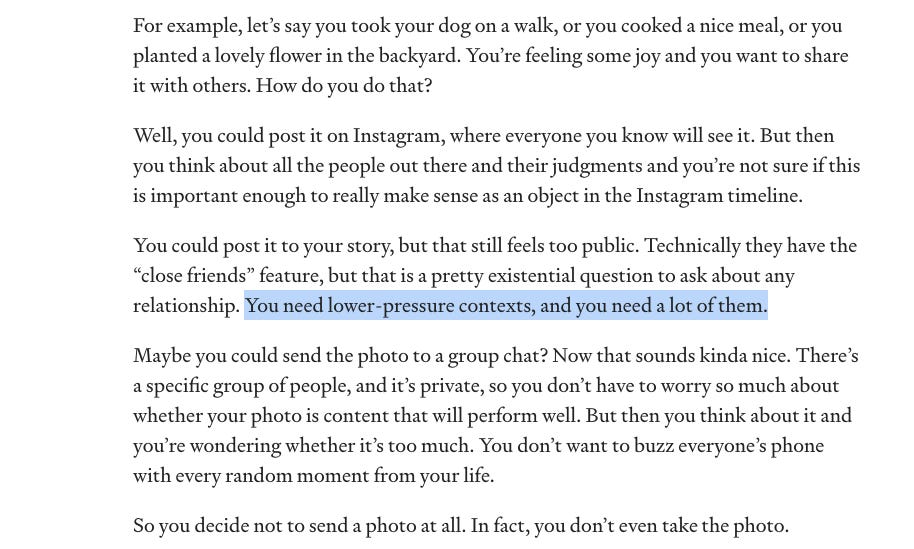Our current digital social contexts force us to be “always on.” Slack, Email, and even newcomers like Clubhouse increasingly optimize for a communication flow that is synchronous, which requires both parties to be actively involved in the conversation. Synchronous communication mostly mirrors our mode of communicating in person, where you’re actively engaged in the conversation, but when you move that process to the digital medium, there’s a formality that is associated with the translations to the digital format that puts heavier pressure on each interaction. It’s why “zoom fatigue” is universal and we’ve started to hate our devices as we’ve had to rely on them for social interaction.
In this sort of world, our energy is constantly being drained, and it’s hard to just let out hair down. How can we cultivate more environments that feel safe and allow you to truly embrace your authentic self, while also preserving the magic of spontaneity that comes from a broad and open social platform?
Dispo was one of the first to champion this in a grounded execution. It was able to tackle the problem of “where do I post and what does it mean when I post in that context given who can see it?” by pushing the moment of share to a significant delay from when you take the photo (9am the next day) and moving the synchronous communication to an async “add to roll.”

And even though the need for this will be lessened as life returns to normal, and people have outlets for in-person connection to escape from the zoom fatigue, we’ll still do a large amount of interaction digitally, and for those interactions, we will still find greater ease expressing ourselves in lower-pressure contexts.
Where else can we provide lower-pressure contexts? What other kinds of content would we like to share? What would this look like applied to latent ideas or interesting links or short thoughts?
In the end, we want these lower pressure contexts because we want to put ourselves out there to find our vibe tribe. The broadness of the internet allows us to interface with so many people we normally wouldn’t be able to interact with, and the only way to plug into that vast ocean of posts and avatars is to play the game and post ourselves. Lower pressure contexts are a kind of social environment that provides the psychological safety for us to put our authentic selves into the digital ether and say “I’m here world.”
After a week of my 100 mini-essays, I got some feedback on the fatigue of reading a substantial piece every day and the potential loss of conveying the full idea because of this. I’m making an adjustment to try to keep my essays around 500 word to be more manageable and really focus on creating a stub to express the essence of an idea.
This is the 7th installment in my experiment of publishing raw, lightly edited mini-essays every day towards achieving 100 public pieces. Check out the rationale and the full list here.




I'm going to be the pessimist here 😅 I'm wondering if there are downsides to making things too low pressure 😆 I'm just thinking back to those memes where people make fun of others who post about every little detail in their life (e.g. tweeting about what they ate for breakfast every day). https://www.someecards.com/usercards/viewcard/MjAxMi0yN2I1MWQ5ODk2Mjc2NWE1/ But maybe the idea of finding a vibe tribe is connecting with people who genuinely want to hear about those details?